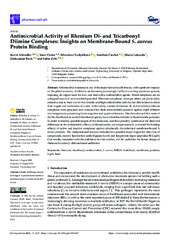Приказ основних података о документу
Antimicrobial Activity of Rhenium Di- and Tricarbonyl Diimine Complexes: Insights on Membrane-Bound S. aureus Protein Binding
| dc.creator | Schindler, Kevin | |
| dc.creator | Cortat, Youri | |
| dc.creator | Nedyalkova, Miroslava | |
| dc.creator | Crochet, Aurelien | |
| dc.creator | Lattuada, Marco | |
| dc.creator | Pavić, Aleksandar | |
| dc.creator | Zobi, Fabio | |
| dc.date.accessioned | 2022-11-15T15:27:56Z | |
| dc.date.available | 2022-11-15T15:27:56Z | |
| dc.date.issued | 2022 | |
| dc.identifier.issn | 1424-8247 | |
| dc.identifier.uri | https://imagine.imgge.bg.ac.rs/handle/123456789/1528 | |
| dc.description.abstract | Antimicrobial resistance is one of the major human health threats, with significant impacts on the global economy. Antibiotics are becoming increasingly ineffective as drug-resistance spreads, imposing an urgent need for new and innovative antimicrobial agents. Metal complexes are an untapped source of antimicrobial potential. Rhenium complexes, amongst others, are particularly attractive due to their low in vivo toxicity and high antimicrobial activity, but little is known about their targets and mechanism of action. In this study, a series of rhenium di- and tricarbonyl diimine complexes were prepared and evaluated for their antimicrobial potential against eight different microorganisms comprising Gram-negative and -positive bacteria. Our data showed that none of the Re dicarbonyl or neutral tricarbonyl species have either bactericidal or bacteriostatic potential. In order to identify possible targets of the molecules, and thus possibly understand the observed differences in the antimicrobial efficacy of the molecules, we computationally evaluated the binding affinity of active and inactive complexes against structurally characterized membrane-bound S. aureus proteins. The computational analysis indicates two possible major targets for this class of compounds, namely lipoteichoic acids flippase (LtaA) and lipoprotein signal peptidase II (LspA). Our results, consistent with the published in vitro studies, will be useful for the future design of rhenium tricarbonyl diimine-based antibiotics. | en |
| dc.publisher | MDPI, Basel | |
| dc.relation | Swiss National Science Foundation [200021_196967] | |
| dc.relation | NCCR Bioinspired Materials | |
| dc.relation | info:eu-repo/grantAgreement/MESTD/inst-2020/200042/RS// | |
| dc.rights | openAccess | |
| dc.rights.uri | https://creativecommons.org/licenses/by/4.0/ | |
| dc.source | Pharmaceuticals | |
| dc.subject | tricarbonyl | en |
| dc.subject | S. aureus | en |
| dc.subject | rhenium | en |
| dc.subject | proteins | en |
| dc.subject | MRSA | en |
| dc.subject | membrane | en |
| dc.subject | LtaA | en |
| dc.subject | LspA | en |
| dc.subject | AutoDock | en |
| dc.subject | antimicrobial | en |
| dc.title | Antimicrobial Activity of Rhenium Di- and Tricarbonyl Diimine Complexes: Insights on Membrane-Bound S. aureus Protein Binding | en |
| dc.type | article | |
| dc.rights.license | BY | |
| dc.citation.issue | 9 | |
| dc.citation.other | 15(9) | |
| dc.citation.rank | M21 | |
| dc.citation.volume | 15 | |
| dc.identifier.doi | 10.3390/ph15091107 | |
| dc.identifier.fulltext | https://imagine.imgge.bg.ac.rs/bitstream/id/55124/Antimicrobial_Activity_of_Rhenium_Di_and_Tricarbonyl_Diimine_Complexes_Insights_on_Membrane_Bound_S_aureus_Protein_Binding_2022.pdf | |
| dc.identifier.scopus | 2-s2.0-85138657787 | |
| dc.identifier.wos | 000859700800001 | |
| dc.type.version | publishedVersion |

